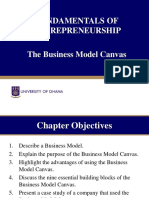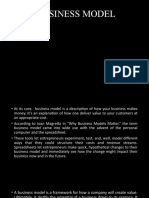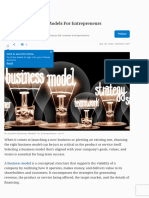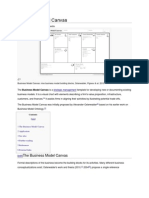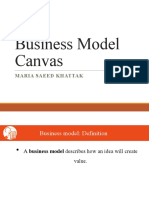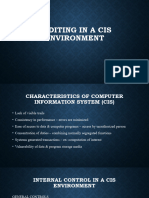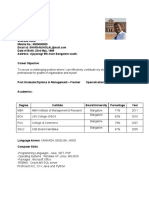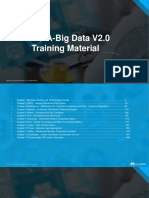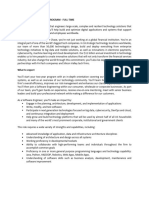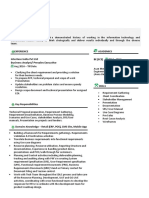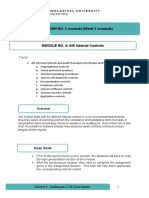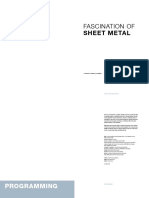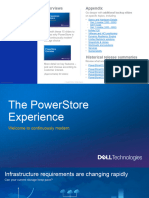BUSINESS MODELS
Lecture 2
�I. What is a Business Model?
• A business model describes how a company creates, delivers, and
captures value.
• A good business model helps a company:
• Understand how it makes money
• Operate efficiently
• Optimize resources for growth
�History of the Business Model Canvas
• The Business Model Canvas (BMC) was
developed by Alexander Osterwalder, a Swiss
business consultant and scholar.
• 2004: Alexander Osterwalder and Professor Yves
Pigneur from the University of Lausanne
(Switzerland) began researching business
models.
�History of the Business Model Canvas
• 2005 - 2008: Osterwalder collaborated with
more than 470 experts from 45 countries to
develop and refine the Business Model Canvas
framework.
• 2010: Osterwalder and Pigneur published the
book “Business Model Generation”, which
provides a detailed explanation of BMC.
��1. Customer Segments – Who are your
customers?
• Identify the customer groups (2-3) your business serves.
• Customers can be individuals (B2C) or businesses (B2B).
• They can be segmented based on age, interests, income, needs, etc.
🔹 Examples:
• Netflix serves multiple customer segments: young movie watchers,
documentary lovers, families, etc.
• Apple targets both individual customers who love premium
technology and businesses needing high-performance devices.
�2. Value Propositions – What value do you
provide to customers?
• What problems does your product/service solve?
• Why should customers choose you over competitors?
• Value can come from high quality, convenience, affordability, brand
reputation, etc.
🔹 Examples:
• Grab offers a fast, convenient, and safe ride-hailing service.
• IKEA provides stylish, affordable, and easy-to-assemble furniture.
�3. Channels – How do you reach your
customers?
• Through what channels do you sell your product/service?
• It can be physical stores, websites, social media, or e-commerce
platforms (Shopee, Amazon, etc.).
🔹 Examples:
• Nike sells through official stores, its website, and retail partners.
• Netflix delivers its service via its website and mobile app.
�4. Customer Relationships – How do you
retain customers?
• How does your business interact with customers?
• Do you offer good customer service?
• Relationships can be managed through email, chatbots, call centers,
loyalty programs, etc.
🔹 Examples:
• Shopee has a cashback program for loyal customers.
• Starbucks uses a mobile app with a rewards program to encourage
repeat purchases.
�5. Revenue Streams – How does the business
make money?
• Do you sell products/services one-time or via subscriptions?
• Do you generate revenue from advertising, commissions, or
transaction fees?
🔹 Examples:
• Netflix operates on a monthly subscription model.
• Google earns revenue from advertising on YouTube and Google Ads.
�6. Key Resources – What does the business
need to operate?
• Essential assets required to run the business model.
• These include people, technology, equipment, brand reputation,
customer data, etc.
🔹 Examples:
• Apple relies on a strong brand, advanced technology, and a talented
engineering team.
• Grab needs drivers, a ride-hailing app, and user data.
�7. Key Activities – What does the business do
to create value?
• Core activities that ensure the business model runs smoothly.
• These include manufacturing, marketing, tech development,
customer service, etc.
🔹 Examples:
• Shopee focuses on platform management, technology development,
and attracting buyers/sellers.
• Starbucks invests in barista training, store expansion, and new
product innovation.
�8. Key Partnerships – Who helps your
business succeed?
• Companies or organizations you collaborate with to grow your
business.
• This includes suppliers, distribution partners, and investors.
🔹 Examples:
• Shopee partners with delivery services like J&T Express and Giao
Hàng Nhanh.
• McDonald's works with farms that supply food ingredients.
�9. Cost Structure – Where does the business
spend money?
• Major expenses involved in running the business.
• Includes rent, employee salaries, marketing, technology, operations,
etc.
🔹 Examples:
• Amazon spends heavily on logistics, warehouses, and technology.
• Netflix invests a lot in producing movies and TV shows.
�II. POPULAR BUSINESS MODELS
1. Traditional Business Model (Brick-and-Mortar)
• Businesses sell products/services in physical stores.
• Examples: Supermarkets, coffee shops, fashion stores.
• Advantages: Customers can experience the product directly.
• Disadvantages: High costs for rent and staff.
�2. E-commerce Model (Online Business)
• Businesses sell products/services online.
• Examples: Shopee, Amazon, Lazada.
• Advantages: Wider customer reach, lower operational costs.
• Disadvantages: High competition, customers can't check product
quality before purchase.
�3. Freemium Model (Free + Premium
Upgrade)
• Provides free basic services, but customers must pay for advanced
features.
• Examples: Spotify (free with ads, paid version removes ads), Canva
(free version with limited features, premium version unlocks more
tools).
• Advantages: Attracts many users.
• Disadvantages: Needs many paying users to be profitable.
�4. Subscription Model
• Customers pay a recurring fee (monthly or yearly) to access a
product/service.
• Examples: Netflix, FPT Play, Apple Music.
• Advantages: Predictable revenue stream.
• Disadvantages: Requires high-quality service to retain customers.
�5. Marketplace Model
• Connects buyers and sellers on a platform.
• Examples: Shopee, Grab, Airbnb.
• Advantages: No need to own products, just manage the platform.
• Disadvantages: Needs a large user base to be sustainable.
�6. Dropshipping Model
• Selling products without holding inventory. Suppliers ship directly to
customers.
• Examples: An online store on Shopee selling T-shirts, but the shirts
are shipped from a manufacturer.
• Advantages: Low startup cost, no inventory management.
• Disadvantages: Dependence on suppliers, difficult to control product
quality.
�7. B2B, B2C, C2C Models
• B2B (Business to Business): Companies sell to other businesses.
• Example: A software company selling accounting software to enterprises.
• B2C (Business to Consumer): Companies sell directly to individual
customers.
• Example: A fashion store selling clothes to customers.
• C2C (Customer to Customer): Individuals sell to each other through a
platform.
• Example: Buying and selling second-hand items on Facebook Marketplace.
�8. Franchise Model
• A company allows others to use its brand and business model to open
new locations.
• Examples: KFC, Highland Coffee.
• Advantages: Rapid brand expansion.
• Disadvantages: Must maintain quality control to protect brand
reputation.
�9. Direct-to-Consumer (D2C) Model
• Businesses sell directly to customers without intermediaries.
• Example: Apple selling iPhones through its own website instead of
third-party retailers.
• Advantages: Better control over pricing and branding.
• Disadvantages: Requires significant marketing investment to reach
customers.
�10. Affiliate Marketing Model
• Businesses pay commissions to individuals or companies that refer
customers.
• Examples: YouTube influencers promoting products with affiliate links.
• Advantages: No upfront advertising costs.
• Disadvantages: Requires monitoring to ensure quality promotions.
�11. Advertising Model
• Provides free content and earns money from advertisements.
• Examples: Facebook, Google, TikTok.
• Advantages: Users don’t have to pay.
• Disadvantages: Relies on a large user base to generate revenue.
�12. Sharing Economy Model
• Platforms that allow people to share resources with others.
• Examples: Airbnb (home-sharing), Grab (ride-sharing).
• Advantages: Reduces asset ownership costs for users.
• Disadvantages: Requires quality control for services.
�BUSINESS
MODEL
CANVAS
�Apple - Customer Segments
• Mass Market: Tech-savvy consumers (iPhone, iPad, Mac
users).
• Premium Segment: High-income individuals seeking luxury
and status (e.g., iPhone Pro, MacBook Pro).
• Businesses: Enterprises using Apple products for productivity
(e.g., MacBooks, iPads).
• Developers: App developers using Apple's ecosystem (App
Store, Xcode).
• Education Sector: Students and schools (discounted
products, educational apps).
�Apple: Value Propositions
• Premium Quality: High-end, durable, and
aesthetically pleasing products.
• Ecosystem Integration: Seamless connectivity
between devices (iPhone, Mac, iPad, Apple Watch).
• Brand Status: Symbol of innovation, luxury, and
exclusivity.
• Privacy and Security: Strong focus on user data
protection.
• Services: Apple Music, iCloud, Apple TV+, App Store,
Apple Pay.
�Apple: Channels
• Direct Channels:
• Apple Stores (physical and online).
• Apple.com website and app.
• Indirect Channels:
• Authorized resellers and retailers (e.g., Best Buy,
Walmart).
• Telecom carriers (e.g., AT&T, Verizon for iPhone sales).
• Digital Platforms:
• App Store, iTunes, iCloud for service delivery.
�Apple: Customer Relationships
• Personal Assistance: In-store Genius Bar for technical
support.
• Self-Service: Online support, tutorials, and forums.
• Loyalty Programs: Trade-in programs, financing
options.
• Community Engagement: Apple events (e.g., WWDC,
product launches).
• Brand Loyalty: Strong emotional connection with
customers.
�Apple: Revenue Streams
• Product Sales:
• iPhone (largest revenue driver).
• Mac, iPad, Apple Watch, AirPods.
• Service Revenue:
• App Store commissions (30% on app sales).
• Subscriptions (Apple Music, Apple TV+, iCloud storage).
• Apple Pay transaction fees.
• Licensing: Revenue from partnerships (e.g., Google for
default search engine).
�Apple: Key Resources
• Brand Reputation: Strong global brand equity.
• Intellectual Property: Patents for hardware and
software.
• Supply Chain: Efficient global manufacturing and
logistics.
• R&D Facilities: Innovation hubs for product
development.
• Ecosystem: iOS, macOS, and app ecosystem.
�Apple: Key Activities
• Product Design and Development: Focus on
innovation and aesthetics.
• Marketing and Branding: High-impact advertising
campaigns.
• Software Development: iOS, macOS, and app
updates.
• Supply Chain Management: Partnerships with
suppliers (e.g., Foxconn).
• Customer Support: In-store and online services.
�Apple: Key Partnerships
• Suppliers: Foxconn, TSMC (chip manufacturing).
• Developers: App developers for the App Store.
• Telecom Carriers: Partnerships for iPhone
distribution.
• Content Providers: Partnerships for Apple TV+ (e.g.,
HBO, Disney).
• Retail Partners: Authorized resellers and retailers.
�Apple: Cost Structure
• R&D Costs: High investment in innovation.
• Manufacturing Costs: Production of hardware (e.g.,
iPhone, Mac).
• Marketing and Advertising: Expensive campaigns and
product launches.
• Retail Operations: Apple Store maintenance and staff.
• Distribution and Logistics: Global supply chain costs.
�BUSINESS
MODEL
CANVAS
�Amazon: Customer Segments
• Mass Market: Online shoppers seeking convenience and
variety.
• Prime Members: Loyal customers paying for premium
services.
• Small and Medium Businesses: Sellers using Amazon
Marketplace.
• Enterprises: Companies using AWS (Amazon Web
Services).
• Developers and Startups: AWS users for cloud computing.
�Amazon: Value Propositions
• Convenience: One-stop shop for everything (e-
commerce).
• Fast Delivery: Prime membership with 1-2 day
shipping.
• Low Prices: Competitive pricing and discounts.
• Cloud Computing: AWS for scalable, reliable cloud
solutions.
• Content and Entertainment: Prime Video, Audible,
Kindle.
�Amazon: Channels
• Direct Channels:
• Amazon.com website and mobile app.
• Amazon Prime app for video and music.
• Physical Channels:
• Amazon Go stores, Whole Foods (after acquisition).
• Amazon lockers for delivery.
• AWS Channels:
• AWS website and sales teams for enterprise clients.
�Amazon: Customer Relationships
• Self-Service: Easy-to-use website and app.
• Automated Services: AI recommendations, Alexa
support.
• Customer Support: 24/7 chat, email, and phone
support.
• Prime Membership: Loyalty program with exclusive
benefits.
• Enterprise Support: Dedicated AWS account
managers.
•
�Amazon: Revenue Streams
• E-commerce Sales:
• Retail sales (products sold directly by Amazon).
• Third-party seller fees (Marketplace commissions).
• Subscription Services:
• Amazon Prime membership fees.
• Audible, Kindle Unlimited subscriptions.
• AWS:
• Cloud computing services (largest profit driver).
• Advertising:
• Sponsored ads on Amazon platform.
�Amazon: Key Resources
• Technology Infrastructure: AWS, AI, and logistics
systems.
• Fulfillment Centers: Global network of warehouses.
• Brand Reputation: Trusted e-commerce and cloud
leader.
• Data: Customer data for personalization and analytics.
• Workforce: Large employee base for operations.
�Amazon: Key Activities
• E-commerce Operations: Managing online
marketplace.
• Logistics and Delivery: Fulfillment and shipping
services.
• Cloud Computing: AWS development and
maintenance.
• AI and Innovation: Alexa, machine learning, drones.
• Marketing: Advertising and Prime promotions.
�Amazon: Key Partnerships
• Third-Party Sellers: Marketplace sellers.
• Logistics Partners: UPS, FedEx, and local delivery
services.
• Content Providers: Partnerships for Prime Video (e.g.,
Netflix, HBO).
• AWS Clients: Enterprises using AWS services.
• Retail Partners: Brands selling on Amazon.
�Amazon: Cost Structure
• Fulfillment Costs: Warehousing and shipping.
• Technology Costs: AWS infrastructure, AI
development.
• Marketing Costs: Advertising and Prime
promotions.
• Content Acquisition: Licensing for Prime Video.
• Workforce Costs: Employee salaries and
benefits.
�Apple vs. Amazon: Key Differences
•Customer Segments:
• Apple: Premium, tech-savvy consumers.
• Amazon: Mass market, businesses, and
developers.
•Value Propositions:
• Apple: Premium quality, ecosystem, privacy.
• Amazon: Convenience, low prices, fast
delivery.
�Apple vs. Amazon: Key Differences
•Revenue Streams:
• Apple: Hardware sales, services.
• Amazon: E-commerce, AWS, subscriptions.
•Cost Structure:
• Apple: High R&D and marketing costs.
• Amazon: High fulfillment and technology
costs.
�Conclusion
• Apple focuses on premium products and
ecosystem integration, targeting high-income
consumers.
• Amazon focuses on convenience, low prices, and
scalability, serving a broad customer base.
• Both companies leverage technology and
innovation but have distinct strategies for value
creation.










